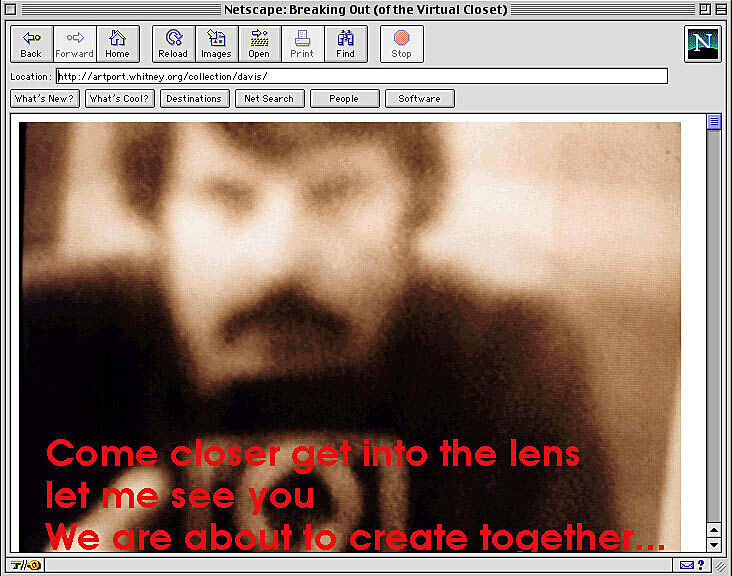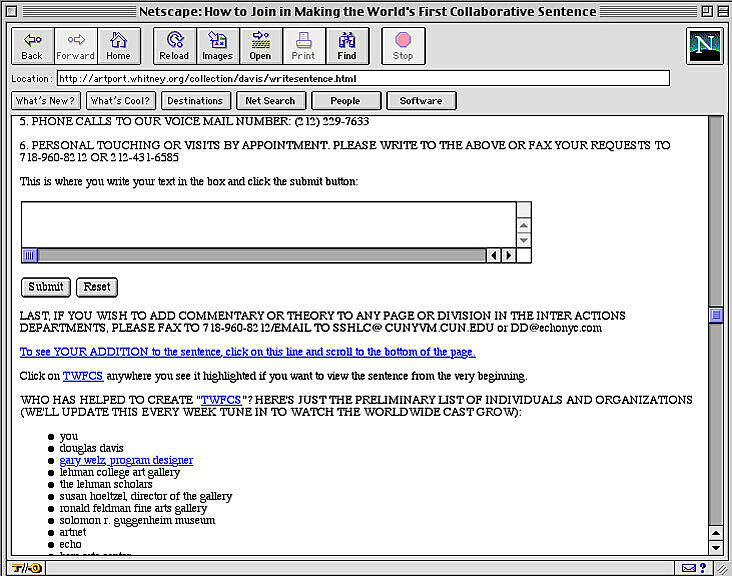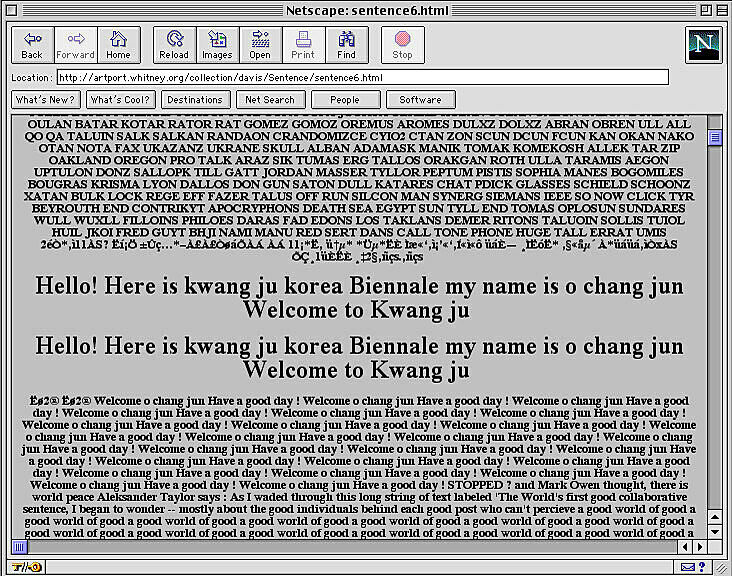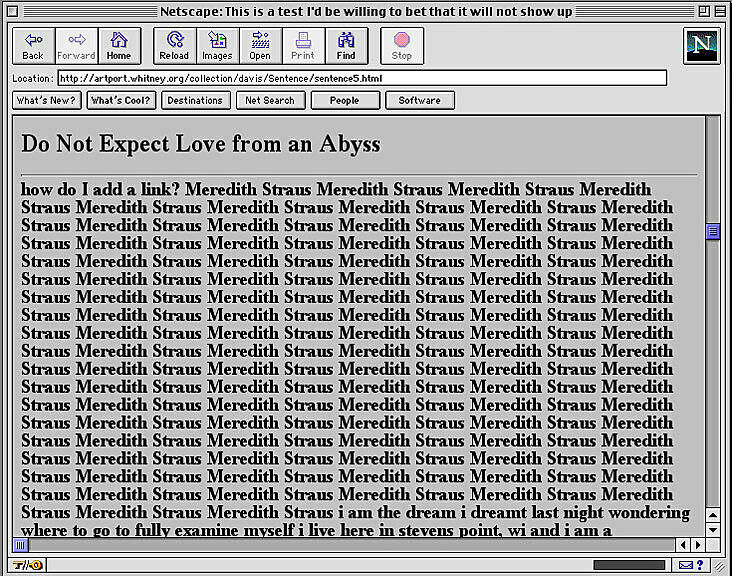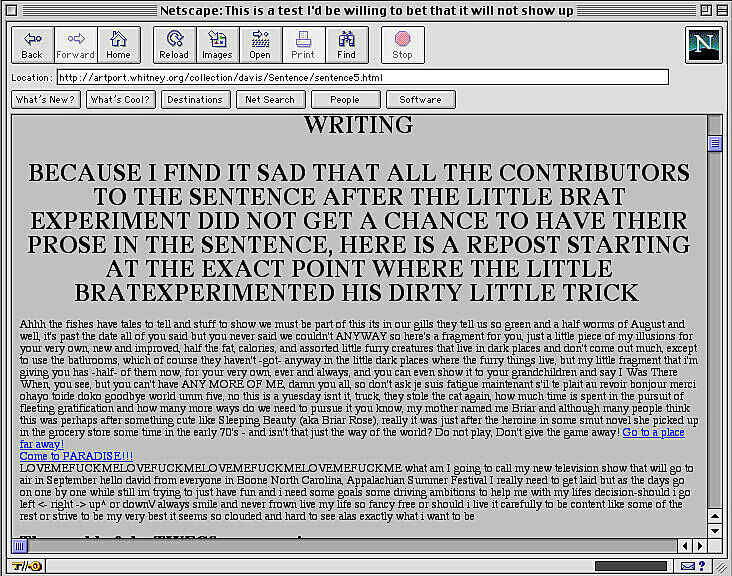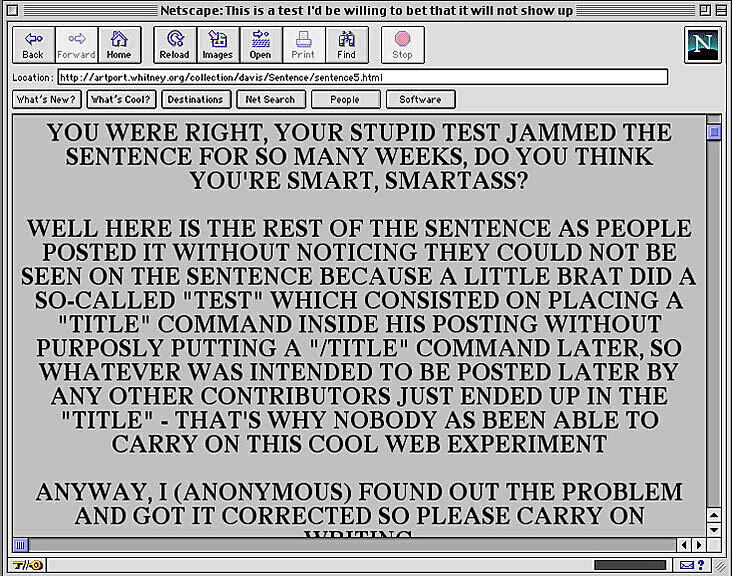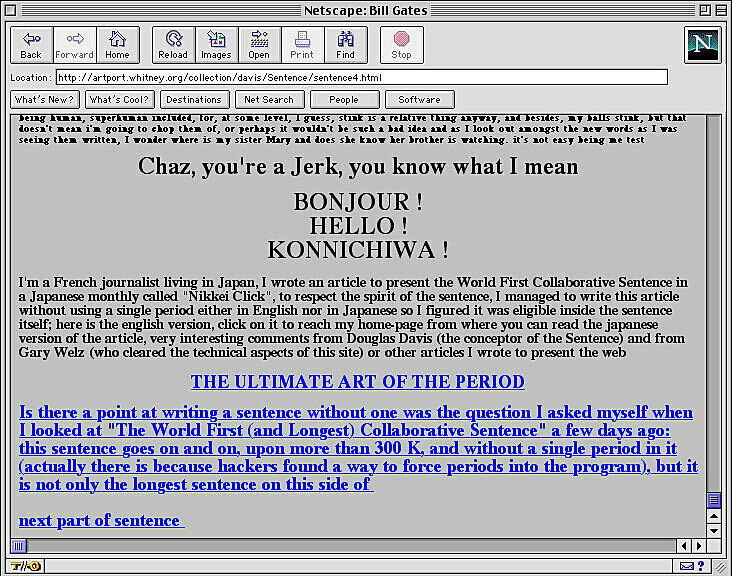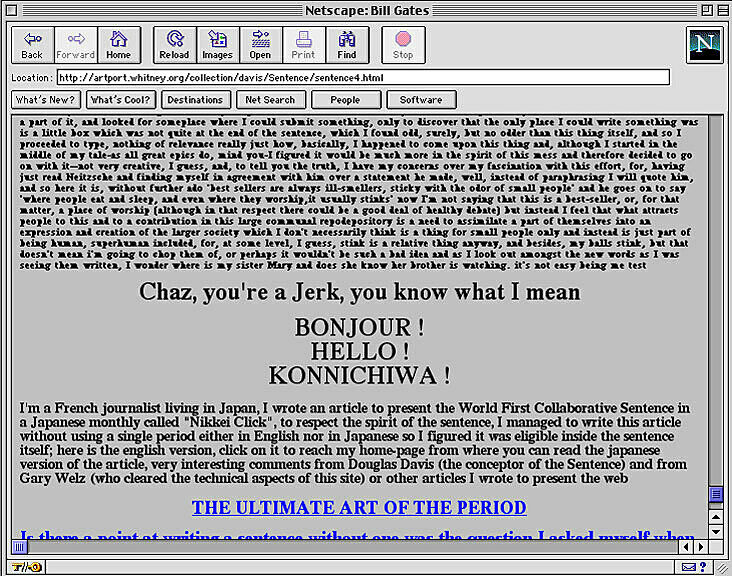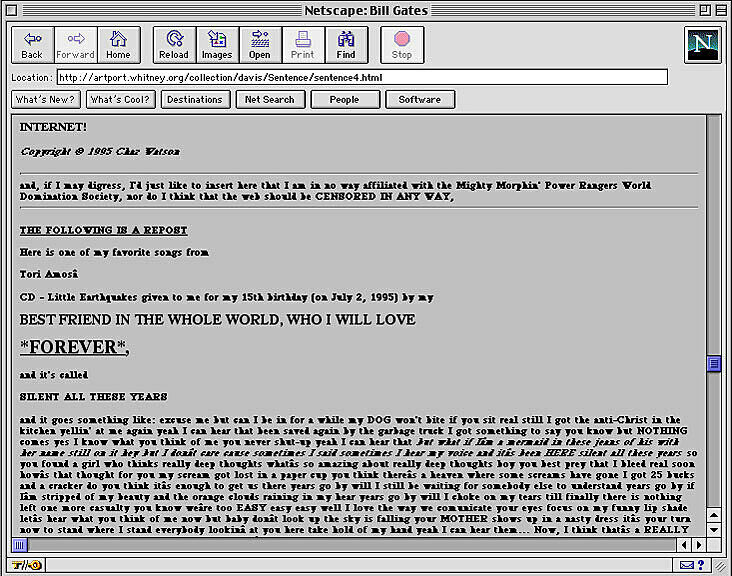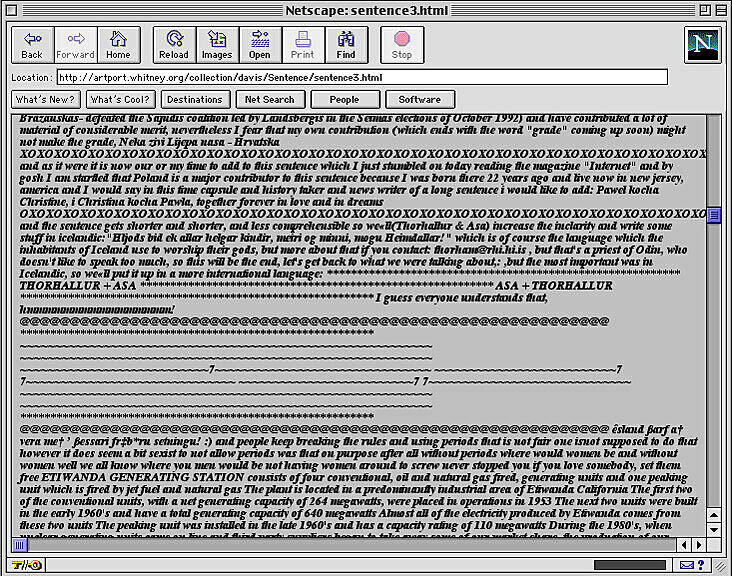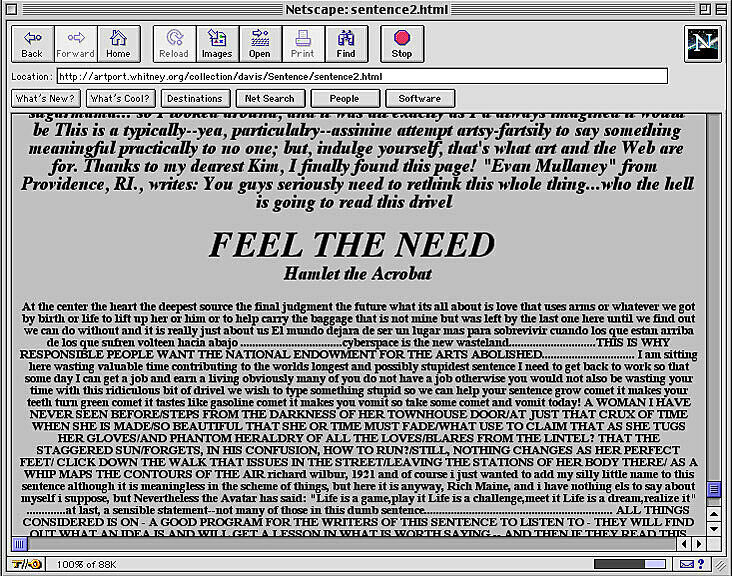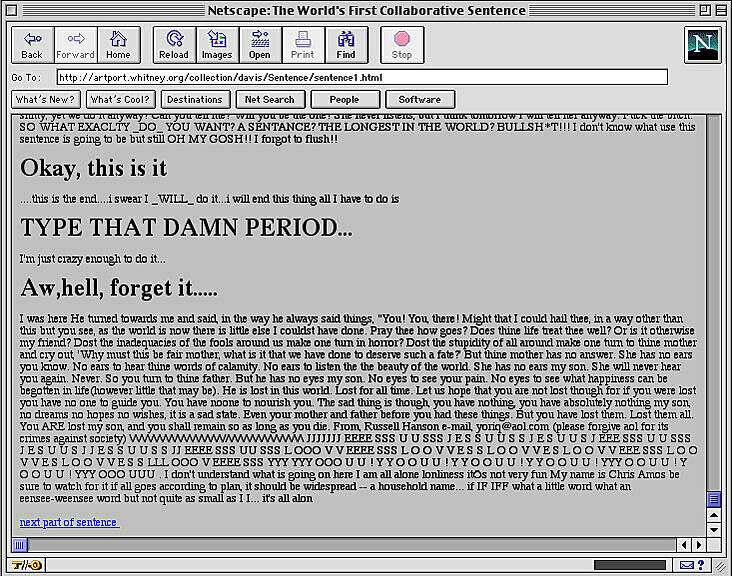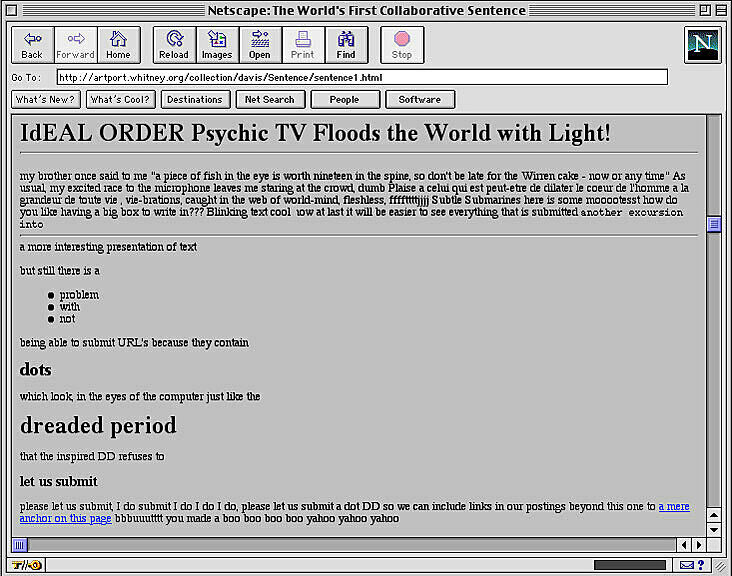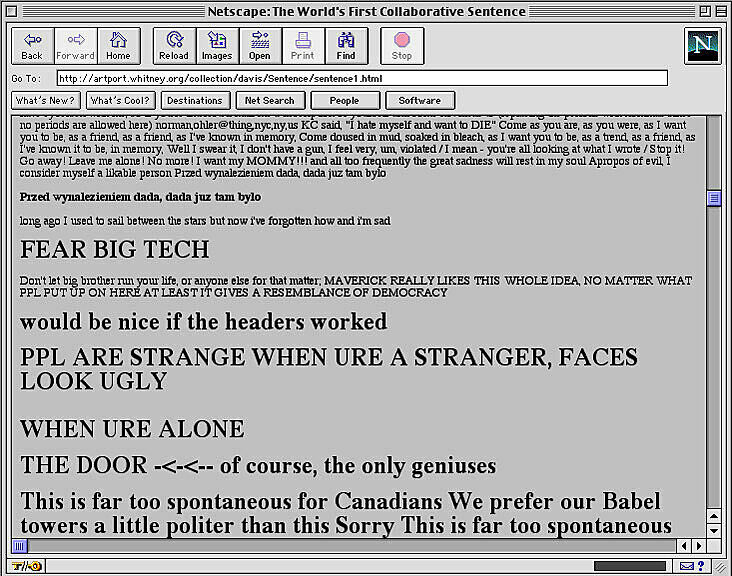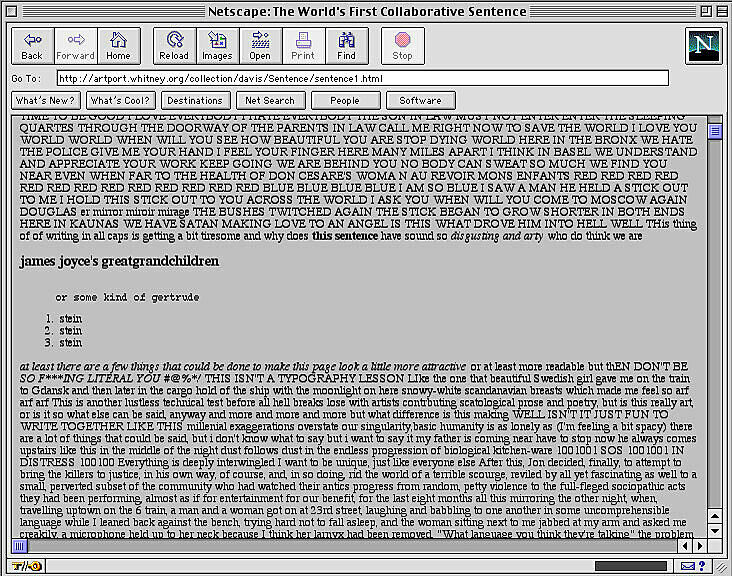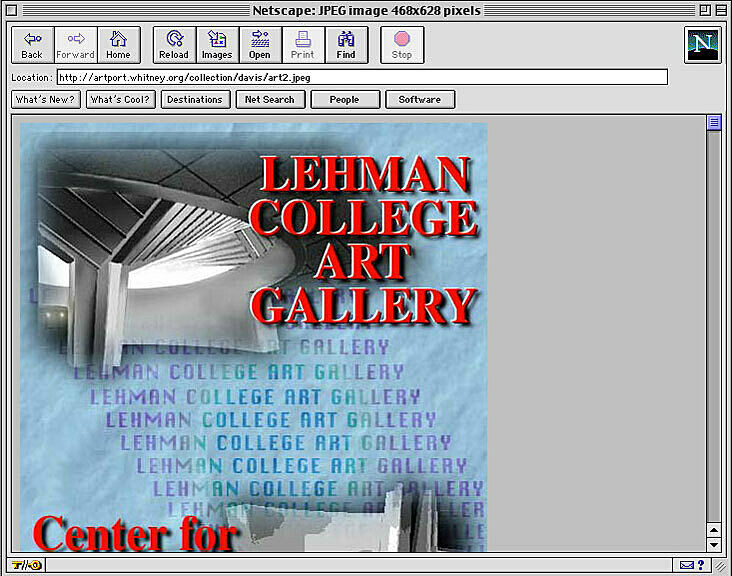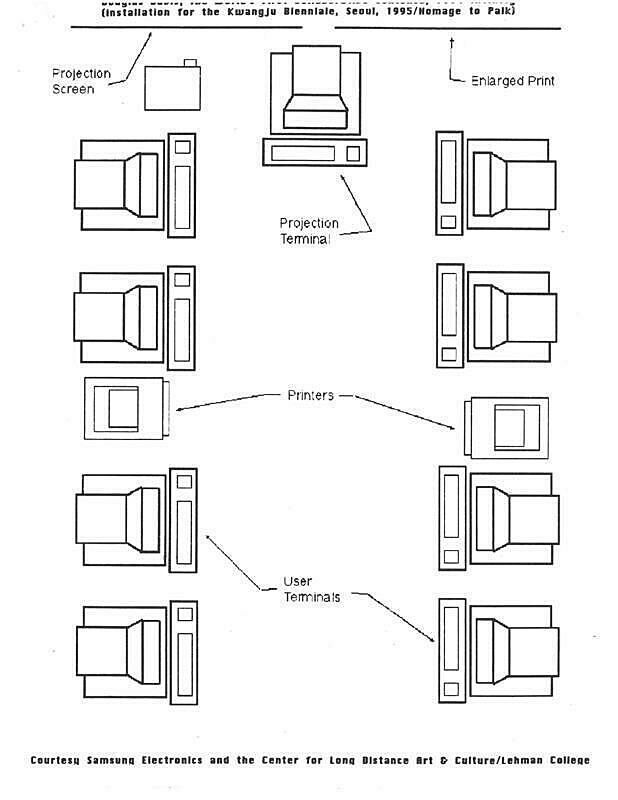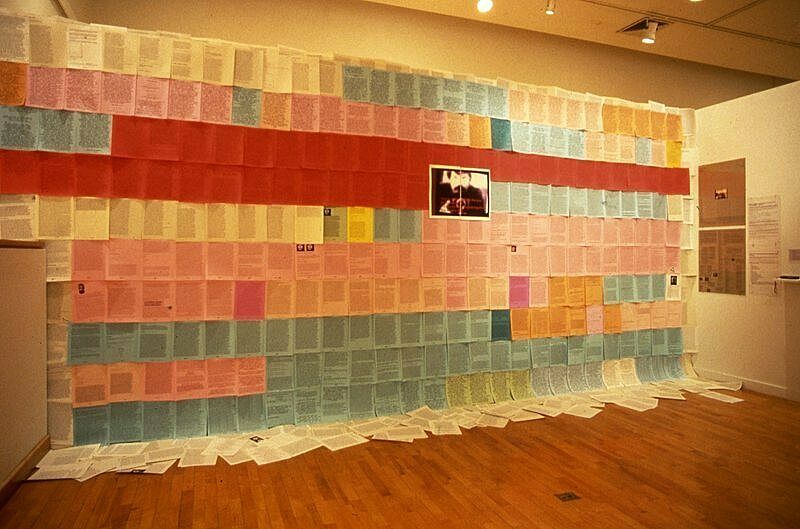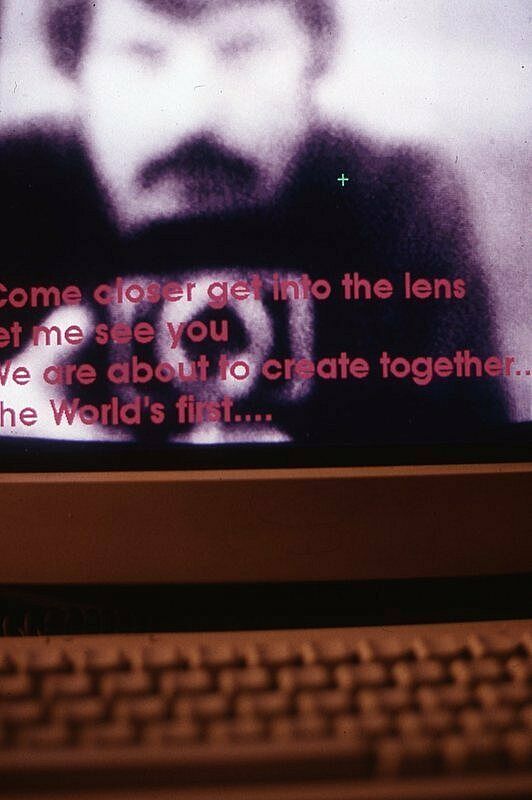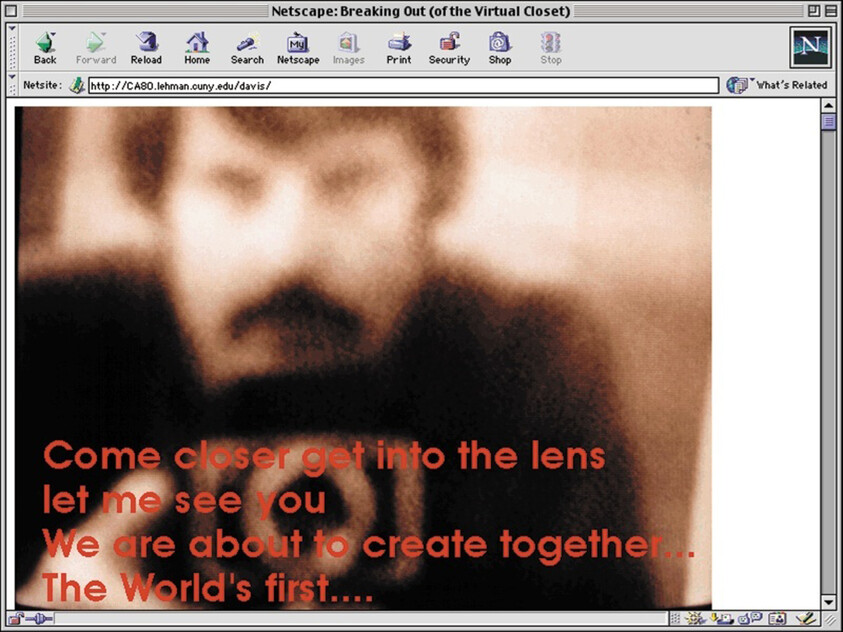Douglas Davis:
The World's First Collaborative Sentence
Launched 1994, Restored 2013
The World’s First Collaborative Sentence, created by Douglas Davis for a survey exhibition of his work in 1994 and donated to the Whitney in 1995, is a “classic” of Internet art. Allowing users to contribute to a never-ending sentence, it anticipated today’s blog environments and ongoing posts. In early 2012 the Whitney Museum undertook a preservation effort spearheaded by Carol Mancusi-Ungaro, Associate Director of Conservation and Research and Christiane Paul, Adjunct Curator of New Media, in concert with Farris Wahbeh, Manager, Cataloguing and Documentation, and implemented by Cass Fino-Radin, digital conservator at Rhizome, and the Museum's Digital Media department. The result of the initiative are the two versions of the Sentence accessible here.
View the live Sentence, or contribute by adding your own words.
"The Sentence has no end. Sometimes I think it had no beginning. Now I salute its authors, which means all of us. You have made a wild, precious, awful, delicious, lovable, tragic, vulgar, fearsome, divine thing."
—Douglas Davis, 2000
Preservation of the Work
Over the years, the experience of the Sentence changed and it became non-functional. The result of the preservation initiative are two versions of the Sentence that address the following issues:
- In the process of migrating the work among servers, crucial files (the CGI script) powering the submission form were omitted.
- Improperly formatted user contributions caused text on several pages of the Sentence to become increasingly large. While older browser versions compensated for this issue and correctly displayed the text, newer ones slowed down as a result, rendering the work essentially unusable.
- Many links contributed by visitors became obsolete (a process referred to as “link rot”) because the pages and files to which they point were moved or deleted.
- When the work was shown at the 1995 Gwangju Biennale in South Korea, the Korean character set was not defined in the header, causing several pages of the Sentence to appear as garbled characters.
1. The new live version
The new live version restores the work’s functionality and allows visitors to contribute to the piece. The display of the work has been promoted to current standards, so that all text is shown at its original size.
- The original links and URLs posted by users in the past were left “broken,” pointing to the ephemeral nature of the Web and the fact that files may vanish over time.
- The issues surrounding the legibility of the Korean character set have not yet been resolved. While most of the characters were rendered legible after the character set was properly defined in the header of the pages, some remained illegible. The Whitney invites contributions via GitHub to make the Korean text legible for the first time.
- Davis’s instructions have been left intact, though contributions via fax and mail are no longer accepted.
2. The restored historic version
The restored historic version leaves the code mainly untouched. Visitors may not contribute to the historic version. Viewed through an old browser, this version would display the Sentence as it appeared at the time of its creation until it stopped functioning in 2005.
- The links have been modified to point to copies of the original pages at the Internet Archive Wayback Machine, a service that allows people to visit archived versions of Web sites (pages created in the early years of the project may not be accessible through the Wayback Machine). The historic version also allows visitors to compare how the design and conventions of Web pages have changed over the years, e.g. the link to whitehouse.gov—embedded in one of the Sentence’s pages—leads to differently designed pages in the live and the historic versions of the Sentence.
- The Korean character set displays as garbled characters.
About the Sentence
Programming: Gary Welz, Robert Schneider.
Originally Commissioned by the Lehman College Art Gallery, The City University of New York, for the exhibition Interactions, curated by Susan Hoeltzel.
Douglas Davis’s The World’s First Collaborative Sentence (1994) is an ongoing textual and graphic online “performance” that was commissioned by the Lehman College Art Gallery, Bronx, N.Y. and The City University of New York, with the assistance of Gary Welz, Robert Schneider, and Susan Hoeltzel. Although the Whitney Museum of American Art acquired the Sentence in 1995 after it was shown in conjuction with Lehman College’s “InterActions,” a 1994 survey exhibition of the artist’s work, the piece was maintained on the website of Lehman College from 1994 until 2005. The work was generously donated to the Whitney by Barbara Schwartz, in honor of Eugene M. Schwartz, her late husband. Together they had purchased the concept and a signed disk with recordings of the first days of the Sentence from the artist.
Visitors to the Sentence may add their own contributions to the webpages—there were more than 200,000 by early 2000, separated into twenty-one “chapters,” in dozens of languages and with a remarkable range of images and graphics. Any subject may be addressed, but no contribution can end with a period, as the Sentence is infinitely expanding.
The World's First Collaborative Sentence is a “classic” of Internet art. With its collaborative, polyvocal, multilingual, and boundless nature, the Sentence became a microcosm of the Web itself. As a decidedly low-tech "multi-user environment" that allows for combinations of textual, visual, and aural components, it is a collective space which, in its broad array of voices and topics, achieves fluent transitions between the prosaic and the sublime.
Douglas Davis, The World’s First Collaborative Sentence, 1994–, conserved 2012. Historic version: HTML and CGI script; live version: HTML and PHP script. Whitney Museum of American Art, New York; gift of Barbara Schwartz in honor of Eugene M. Schwartz 95.253. Originally commissioned by the Lehman College Art Gallery, The City University of New York, with the assistance of Gary Welz, Robert Schneider, and Susan Hoeltzel
Artist's Statement, April 4, 2000
It began in December 1994, when the Lehman College Art Gallery and its director, Susan Hoeltzel, commissioned The World’s First Collaborative Sentence as part of “InterActions,” a survey of Douglas Davis’ early work (1967-81) in a variety of media, from drawing, printmaking, and photography to performance, videotapes, and live satellite television broadcasting. Using a server provided by the City University of New York (CUNY)—and working closely with professor Robert Schneider in the department of mathematics at Lehman College—Davis documented the exhibition on the Web and created an entirely new work linked to the exhibition’s theme.
Unveiled on December 7, 1994, the site was linked to a live performance in the Lehman College Art Gallery. Artist Nathalie Novarina, participating in the performance via phone from Geneva, supplied the Sentence's maiden image and its first words. In collaboration with Gary Welz, Davis designed the formal interactive structure of the Sentence.
In January 1995, Barbara and the late Eugene M. Schwartz purchased both the concept of the Sentence and the site itself. As a symbol of ownership, the Schwartzes received a disk that recorded the first days of the site, including the earliest contributions. The Schwartzes' generosity allowed further work to be done on the design of the Sentence as well as a revision of the introductory homepage that adds information about the meaning and intention of the work. Professor Schneider has maintained the Sentence on the Web for over ten years, breaking up the enormous volume of contributions into separate "chapters" (there are now twenty-one). Susan Hoeltzel, moreover, has actively encouraged the evolution of the Sentence at every step. The work was included in several interactive installations—at the Kwangju Biennale in Korea in 1995, at the School of Visual Arts' "Digital Salon" exhibition later that year (which toured internationally), and in 1999 at the Zentrum für Kunst und Medientechnologie (ZKM) in Karlsruhe, Germany (as part of the exhibition "net.condition")—all of which attracted thousands of online contributions.
In 1995, Mrs. Schwartz donated the Sentence to the Whitney Museum of American Art. Davis commemorated the Whitney's acquisition of the Sentence by designing, with Vincent M. Spina, a logo—W-M Music—which now lives among the year 2000 contributions to theSentence itself. W-M stands for "Wrap Music," a series of audio files that includes conceptual song making and historic sounds sent to the Sentence in its earliest days.
From its inception, the Sentence has received a torrent of words, sounds, and images , contributors having learned about the site by word-of-mouth, web-based references, or press attention. The appeal of the Sentence is that it gives the world a space in which to speak its collective and its individual mind.*
As of early 2000, the estimated number of actual contributions neared 200,000 and incorporated dozens of languages. The only "rule" of the Sentence is that no one is allowed to type a period at the end of their contributions. Though ingenious users have occasionally found ways to break this rule, the vast majority have abided by it with great passion, criticizing those who discover ways to type a period at the end of a grammatically completed thought. The Sentence may well go on forever, or at least until a superior force or the limitations of web technology calls a halt to it.
As the skills of users have increased, the Sentence has grown to incorporate far more than words. In addition to texts, there are now photographs, video, sounds, graphics, and links to thousands of other websites, contributed by people of all ages and cultures. Among the contributions are musings, rants, lyrical poems, political and spiritual tracts, fragments of thought, and philosophical speculation, as well as occasional vulgarities. They address such concerns as art, literature, sexuality, religion, the nature of play, the meaning of the "sentence" itself, and the vaster subjects of life and death.
Douglas Davis is grateful to all those who are writing and designing the Sentence and regards them as fully equal collaborators. He also thanks the original sponsors of the Sentence at the Lehman College Art Gallery, the students of Lehman college, and Barbara and the late Eugene M. Schwartz.
"The Sentence has no end. Sometimes I think it had no beginning. Now I salute its authors, which means all of us. You have made a wild, precious, awful, delicious, lovable, tragic, vulgar, fearsome, divine thing."
—Douglas Davis
*The interplay between collective and individual collaborative writing envisioned by Davis in 1994 has since been implemented in blogs and wikis.
The Sentence as it appeared in 1994
These screenshots show the historic version of the Sentence viewed through an early verison of the Netscape browser.
Photographic Documentation, 1995–96
Between 1994 and 2000, The World’s First Collaborative Sentence was exhibited in gallery spaces including Lehman College Art Gallery, Bronx New York; the 1995 Gwangju Biennale, South Korea; and the Whitney Museum of American Art, New York. The below floor plan, installation view, and "official image" of the Sentence provide insight into the work’s distinct materiality.
In the News
"When Artworks Crash: Restorers Face Digital Test"
—The New York Times
"Restoring The World's First Collaborative Sentence"
—Rhizome


